August 21, 2020
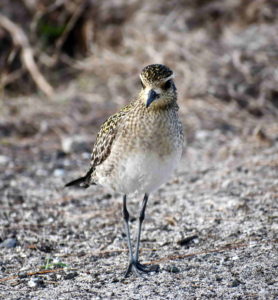
A plover in typical winter plumage. ©Susan Scott
The feathered jury is in: Our Kolea are back. Plovers are appearing throughout the state, some old friends returning to favored yards, and other old-timers landing in parks, golf courses, cemeteries, campuses and other open areas. I call them old-timers because the first August birds are usually adult females, followed by adult males. This summer’s offspring will stay in Alaska tundra for as long as the bugs and berries hold out, sometimes as long as November. When the snows bury their food sources, the youngsters will fly, unguided by adults, to Hawaii. Those that make it here must then secure a foraging spot to survive their first winter.
Every aspect of plover life is remarkable, a fact noted often by Hawaii’s residents. Since the early 1990s, plover lovers have been writing me about their Pacific Golden-Plover’s arrival and departure dates, number of years in their yard, food preferences, nicknames, amusing habits, and so on. To answer the many questions Kolea fans had about these charming migratory birds, plover expert, Dr. Wally Johnson, and I coauthored a Kolea book koleacount.org/kolea-book in 2016 using facts Wally learned during a lifetime of Kolea research.
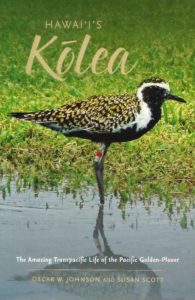
But questions remain. No one knows if the Hawaii population is increasing, decreasing, or remains stable. Also, are the July returns we see early or typical? In spring, do all the birds leave for Alaska the same day? (My two were still here May 12th, about two weeks after most had gone.) How many Kolea spend summers here?
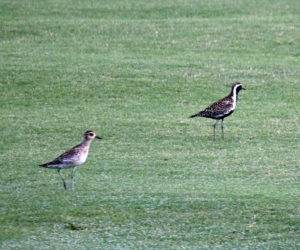
My birds, Jake and Julie, were in Kailua this year well into May. The last we saw Julie, the female (left) was May 12th. Jake stuck around until May 14th. © Susan Scott
With Wally’s guidance, in March I launched the trial website koleacount.org sponsored by the Hawaii Audubon Society, to engage the community in recording their Kolea observations, and answer some of these questions. Enthusiastic entries arrived throughout the spring and summer, and continue to this day. Now we’re gearing up for Hawaii’s first all-volunteer, statewide Kolea Count.
We’re starting the count December 1st, which gives first-year birds time to reach Hawaii, stake out territory, and survive (or not.) First year birds that make it through their first winter have a good chance for a long life of 6-to 21 years. Starting the count in December also gives me time to work out details.
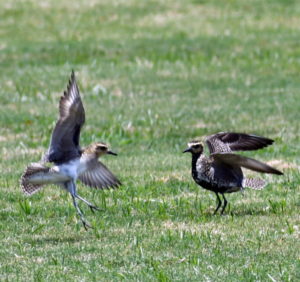
Kolea fighting over territory in Punchbowl in May. The bird on the left did not molt into spring breeding colors and spent the summer in that area, previously “owned” by the female on the right. She left in late April. ©Susan Scott
I’ve divided the count into Little Counts and Big Counts. Little Counts are for those who want to record one bird, or a few, in their yard, neighborhood, church, or school grounds. If the number changes during the winter, report it on the Kolea site above using the same location each time. The report page has changed a bit. Because some counters asked that their names and addresses remain private, I removed the public database from the Kolea Count site. To simplify reporting, I also eliminated the map step. We know where the birds are by the location report.
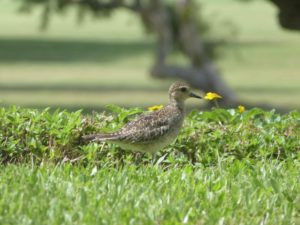
Little counts are for birds in a backyard, such as this one, or the small lawn of a school, church, etc. ©Susan Scott
Big Counts are for those who can count plovers on golf courses, cemeteries, parks, and other large areas. I’ve made a preliminary list, bit.ly/2BFwVXG, of many of those areas using Google Maps. This is my first attempt at identifying Kolea habitats throughout the Islands, so please let me know plover areas I missed, and I’ll add them to the list.
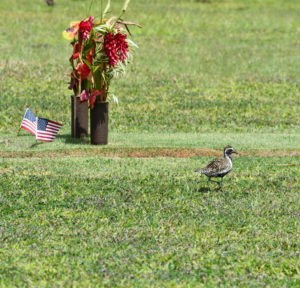
Big counts are cemeteries, parks, golf courses, campuses, and other open areas.© Susan Scott
To keep names and email addresses confidential, the Big Count signup is a read-only document. Send me your location choice, name and email address. I will add the X for Taken, which grays out the site, and keep a private master list with your name and email.
Choose as many sites as you would like to count, and report each one three times between December 1 and March 31. I’ll average the numbers. Count more times if you like, less if you can’t do three. All data help.
The response to this Kolea Count has been a bit overwhelming, which I view as a good thing during these challenging times. I’ve received emails from nearly 500 plover lovers and the number keeps growing. That fact prompted Wally to email this week, “Maybe the Kolea in Hawaii is the most revered bird by the general populace in the world!”
Craig and I have been enjoying scouting Oahu plover sites by foot, car, and bicycle, making Kolea quests a good antidote for the Covid-19 blues. Join us in the fun. And thank you for your patience as I work out how to manage the project.
It’s fine to report your returned bird this fall, and also to sign up to count a larger area this winter, starting in December. (To answer a common question: Wally says that we cannot definitely tell males from females when they return to Hawaii because the birds start molting while still sitting on their eggs. Kolea may have remnants of spring breeding colors but we don’t know the sex for sure until spring. You can report your bird again in April as male or female.)
Report all Little Counts and Big Counts at koleacount.org/report/
Here’s a link to Kolea Count Guidelines in brief, and an illustration of the new Kolea Count T-shirts on order: koleacount.org/kolea-count-guidelines-a-community-project/
Contact me any of the following ways:
email: honu@susanscott.net